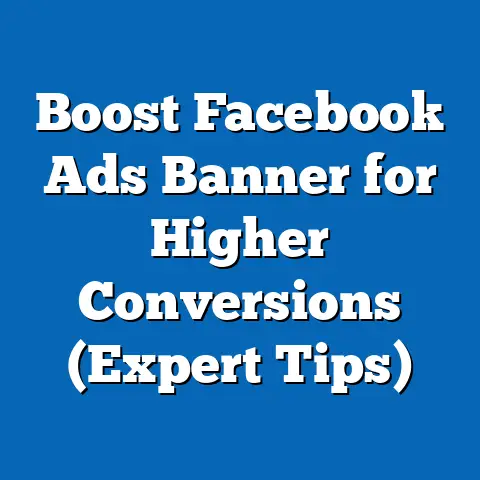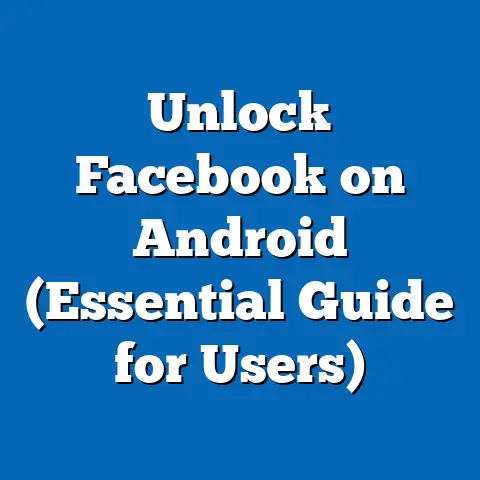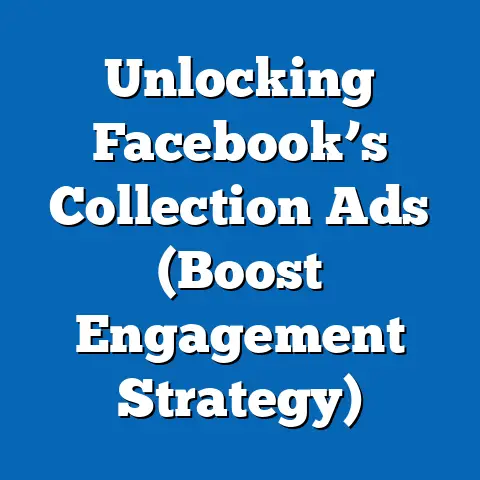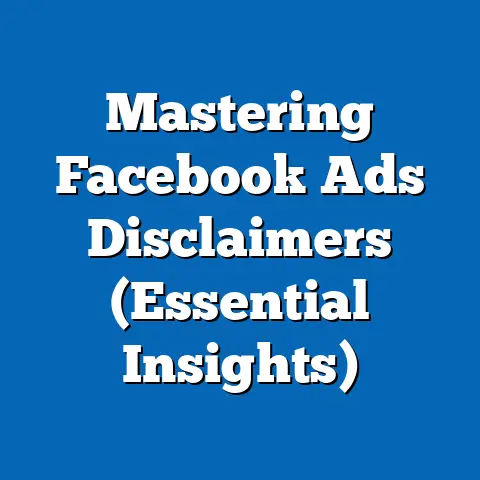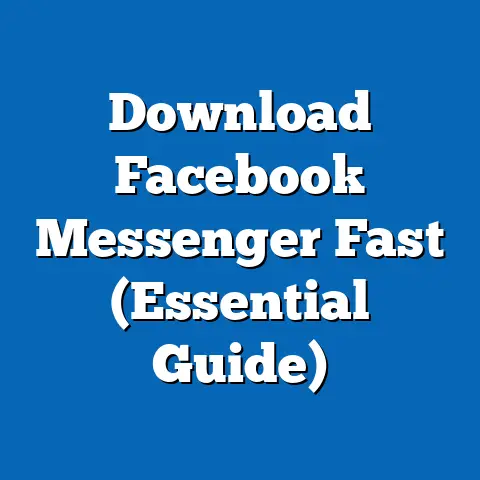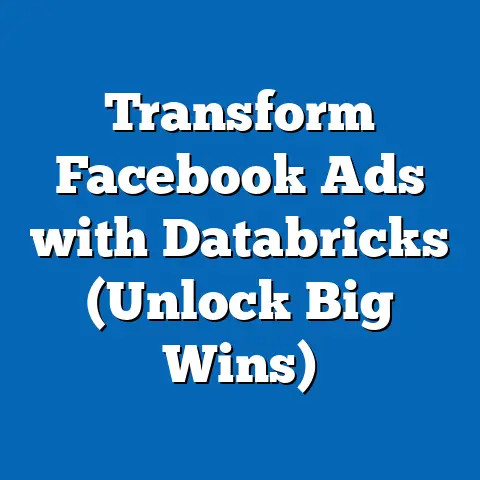Master Facebook Ad Copy Rules (Essential Guide for Success)
Have you ever scrolled through your Facebook feed and stopped dead in your tracks for an ad that seemed to speak directly to you? What made that ad so irresistible—was it the image, the offer, or the words that hooked you? In the world of digital marketing, crafting compelling Facebook ad copy is the secret sauce that can transform a casual scroller into a loyal customer.
Facebook remains a powerhouse in the advertising realm, with over 2.9 billion monthly active users as of 2023, according to Statista. This massive audience spans diverse demographics, with 69% of U.S. adults using the platform (Pew Research Center, 2023), making it a critical space for businesses to connect with potential customers. However, with over 10 million active advertisers on Facebook (Hootsuite, 2023), standing out in a crowded feed is no easy feat.
The stakes are high: a well-written ad can drive click-through rates (CTR) as high as 3-5%, while poorly crafted copy often languishes below 0.5%, per WordStream’s 2023 industry benchmarks. As advertising costs rise—Facebook’s average cost-per-click (CPC) increased by 17% year-over-year to $1.72 in 2023 (AdEspresso)—mastering ad copy isn’t just a skill; it’s a necessity for maximizing return on investment (ROI). This guide dives deep into the rules, strategies, and data-driven tactics to craft Facebook ad copy that converts, backed by the latest research and real-world insights.
Section 1: Understanding the Facebook Advertising Landscape
1.1 The Evolution of Facebook Ads
Facebook advertising has come a long way since its inception in 2007. Initially, ads were simple sidebar banners with limited targeting options. By 2023, the platform offers hyper-specific targeting based on interests, behaviors, and demographics, alongside dynamic ad formats like Stories, Carousel, and Video ads.
Historically, the average CTR for Facebook ads hovered around 0.9% in 2015, but increased competition and algorithm changes have pushed industry averages to 1.11% in 2023 (WordStream). This shift reflects both user fatigue and the need for more engaging content. Businesses that fail to adapt to these trends risk wasting ad spend on ineffective campaigns.
1.2 Demographic Insights: Who’s on Facebook?
Understanding your audience is the foundation of great ad copy. According to Pew Research Center (2023), Facebook’s user base in the U.S. includes 74% of adults aged 18-29, 70% of those aged 30-49, and 54% of those over 50. Gender distribution is nearly even, with 67% of men and 71% of women using the platform.
Globally, Statista (2023) reports that India has the largest Facebook audience at 314 million users, followed by the U.S. with 240 million. These demographics highlight the platform’s reach across age groups and regions, but also the need for tailored messaging. For instance, younger users (18-24) are more responsive to trendy, visually driven ads, while older users (50+) often engage with value-driven, problem-solving copy, per a 2022 study by Sprout Social.
1.3 The Cost of Attention: Rising Ad Costs
Facebook ad costs have surged in recent years due to increased competition and privacy changes like Apple’s iOS 14 update, which limited tracking capabilities. The average cost-per-thousand-impressions (CPM) rose to $14.40 in 2023, up 24% from 2021 (AdEspresso). For small businesses with tight budgets, this means every word in an ad must work harder to capture attention and drive action.
Section 2: The Core Rules of Crafting High-Performing Facebook Ad Copy
2.1 Rule #1: Know Your Audience Inside Out
Effective ad copy starts with deep audience research. Use Facebook’s Audience Insights tool to analyze interests, behaviors, and demographics of your target market. For example, a fitness brand targeting women aged 25-34 might discover through Insights that their audience frequently engages with content about yoga and healthy eating—key themes to weave into ad copy.
A 2022 study by HubSpot found that personalized ads increase CTR by 14% compared to generic messaging. Tailor your language to address specific pain points or desires. Instead of “Get Fit Today,” try “Busy Moms: Transform Your Body in Just 15 Minutes a Day.”
2.2 Rule #2: Lead with a Strong Hook
The first 2-3 seconds of an ad determine whether a user stops scrolling. According to a 2021 Nielsen study, 74% of users decide to engage with content within the first 3 seconds. Start with a bold question, surprising statistic, or emotional statement to grab attention.
For instance, an ad for a financial app might open with: “Struggling to Save? 78% of Americans Live Paycheck to Paycheck—Don’t Be One of Them.” This approach, backed by a real stat from a 2023 Federal Reserve report, immediately resonates with the audience’s pain point. Keep hooks concise—Facebook truncates text after 125 characters in the main feed, so front-load your most compelling message.
2.3 Rule #3: Focus on Benefits, Not Features
Users don’t care about what your product does; they care about how it improves their lives. A 2023 survey by MarketingSherpa revealed that benefit-driven ads outperform feature-focused ads by 22% in terms of conversion rates. Instead of saying “Our App Has 50+ Workout Plans,” say “Achieve Your Dream Body with Personalized Workouts.”
Highlight tangible outcomes like saving time, reducing stress, or boosting confidence. Use specific numbers when possible—e.g., “Save $500 a Year on Groceries with Our Meal Planner”—as specificity builds trust, per a 2022 study by the Journal of Consumer Research.
2.4 Rule #4: Use Action-Oriented Language
Strong calls-to-action (CTAs) are non-negotiable. WordStream’s 2023 data shows that ads with clear CTAs like “Shop Now,” “Learn More,” or “Sign Up Free” see 28% higher CTRs than those without. Avoid vague phrases like “Click Here” and opt for urgent, value-driven CTAs like “Claim Your Free Trial Before It’s Gone!”
Incorporate urgency and scarcity to drive immediate action. Phrases like “Limited Time Offer” or “Only 5 Spots Left” tap into fear of missing out (FOMO), a tactic that boosted conversion rates by 17% in a 2021 experiment by OptinMonster.
2.5 Rule #5: Keep It Short and Scannable
Attention spans on social media are fleeting—Microsoft’s 2020 research pegs the average at just 8 seconds. Long-winded copy risks losing readers before they reach the CTA. Aim for primary text of 50-100 words and headlines of 5-10 words, per Facebook’s own best practices.
Break text into short lines or bullet points for readability. For example, instead of a dense paragraph, list benefits like: – Save 2 Hours a Week – Cut Costs by 30% – Get Results Fast This format, tested by Buffer in 2022, increased engagement by 15% compared to block text.
2.6 Rule #6: Leverage Social Proof
People trust recommendations from others over brand claims. A 2023 Nielsen report found that 92% of consumers trust peer reviews and testimonials over traditional advertising. Include customer quotes, star ratings, or stats like “Join 10,000+ Happy Customers” in your copy.
User-generated content (UGC) also works wonders. An ad featuring a real customer’s success story—e.g., “Sarah Lost 20 Pounds with Us!”—can boost credibility. According to Stackla (2022), UGC-driven ads see 4x higher click-through rates than branded content.
2.7 Rule #7: Test Emotional Triggers
Emotions drive decisions more than logic. A 2021 study by the Harvard Business Review found that ads appealing to emotions like joy, fear, or curiosity outperform rational appeals by 31% in terms of engagement. For example, a pet product ad might tug at heartstrings with “Give Your Dog the Life They Deserve.”
However, balance emotion with authenticity—overly manipulative copy can backfire. Test different tones (humor, empathy, excitement) to see what resonates with your audience via A/B testing, a method we’ll explore later.
Section 3: Advanced Strategies for Facebook Ad Copy Success
3.1 A/B Testing: The Key to Optimization
No single ad copy formula works for every audience. A/B testing—running two versions of an ad with one variable changed (e.g., headline or CTA)—helps identify what drives results. According to Optimizely (2023), businesses that regularly A/B test their ads see 20-30% higher conversion rates.
Start by testing small elements: a question vs. a statement in the headline, or “Buy Now” vs. “Shop Today” in the CTA. Run tests for at least 7 days to gather statistically significant data, as recommended by Facebook’s Ads Manager guidelines. Use tools like Ads Manager’s split testing feature to track metrics like CTR, CPC, and conversions.
3.2 Ad Format-Specific Copy Tips
Different ad formats demand unique copy approaches. For Carousel ads, which allow multiple images or products, write micro-copy for each card—e.g., “Card 1: Save 20% on Shoes; Card 2: Free Shipping Today.” A 2022 study by Socialbakers found Carousel ads have 1.5x higher CTRs than single-image ads when paired with targeted text.
For Video ads, focus on captions since 85% of users watch videos without sound (Facebook, 2023). Use bold, benefit-driven text like “Transform Your Skin in 7 Days!” overlaid on the first frame. Stories ads, meanwhile, thrive on urgent, vertical copy like “Swipe Up for 50% Off—Today Only!”
3.3 Retargeting Copy: Winning Back Lost Leads
Retargeting ads target users who’ve interacted with your brand but didn’t convert. These ads have a 10x higher CTR than standard display ads, per WordStream (2023). Use personalized copy like “Hey, You Left Something in Your Cart—Come Back for 10% Off!”
Address objections directly. If a user abandoned a purchase due to price, test copy like “Still Thinking? Get Free Shipping on Your First Order.” A 2021 Criteo study found retargeting ads with discount offers increase conversions by 43%.
Section 4: Common Pitfalls to Avoid in Facebook Ad Copy
4.1 Overpromising or Misleading Claims
Exaggerated claims like “Lose 50 Pounds in a Week!” can attract clicks but damage trust. Facebook’s Advertising Policies strictly prohibit false promises, and violators risk ad rejection or account suspension. A 2022 report by eMarketer noted that 68% of users distrust ads with unrealistic claims, leading to higher bounce rates.
Stick to verifiable benefits and back claims with data or testimonials. Transparency builds long-term loyalty, as evidenced by brands like Patagonia, whose honest messaging drives a 74% customer retention rate (Statista, 2023).
4.2 Ignoring Mobile Optimization
With 98.5% of Facebook users accessing the platform via mobile devices (Statista, 2023), copy must be mobile-friendly. Long paragraphs or tiny text in images frustrate users, leading to a 40% higher bounce rate, per Google’s 2021 mobile UX study. Use short sentences, large fonts in visuals, and preview ads on mobile before launching.
4.3 Neglecting Compliance with Facebook Policies
Facebook enforces strict rules on ad content, banning explicit language, discriminatory messaging, and certain industries like tobacco or gambling. Non-compliant ads are rejected, costing time and money. A 2023 survey by Hootsuite found that 22% of advertisers faced ad disapprovals due to policy violations, often from unclear CTAs or prohibited claims.
Review Facebook’s Advertising Standards before writing copy. Avoid phrases like “guaranteed results” unless backed by evidence, and steer clear of “before and after” images in weight loss ads, a common policy trigger.
Section 5: Measuring Success and Iterating for Improvement
5.1 Key Metrics to Track
Success in Facebook advertising hinges on data. Focus on these core metrics, per WordStream’s 2023 benchmarks: – Click-Through Rate (CTR): Industry average is 1.11%. A higher CTR signals engaging copy. – Conversion Rate: Average is 9.21%. Low rates may indicate a disconnect between ad promise and landing page. – Cost-Per-Click (CPC): Average is $1.72. High CPC suggests unoptimized copy or targeting. – Return on Ad Spend (ROAS): Aim for at least 3x. Track via Facebook Pixel to measure sales from ads.
Use Facebook Ads Manager to monitor these metrics weekly. If CTR dips below 0.5%, revisit your hook or audience targeting.
5.2 Historical Trends vs. Current Performance
Comparing past and present data reveals evolving user behavior. In 2018, the average Facebook CTR was 0.9%, rising to 1.11% by 2023 due to better targeting tools (WordStream). However, conversion rates dipped from 9.5% to 9.21% as users grew wary of online purchases post-privacy scandals like Cambridge Analytica.
Adapt to these shifts by focusing on trust-building copy. Highlight secure payment options or privacy guarantees—tactics that boosted conversions by 12% in a 2022 Shopify study.
5.3 Visualizing Data for Insights
While raw numbers are critical, visualizing data helps spot trends. Imagine a line graph plotting your ad’s CTR over 6 months: a steady climb from 0.8% to 1.5% might indicate successful copy tweaks, while a sudden drop could signal audience fatigue. Use tools like Google Data Studio or Facebook’s built-in analytics to create such charts.
Bar charts comparing CTR across demographics—e.g., 1.8% for 18-24 vs. 0.9% for 45-54—can guide audience-specific copy adjustments. Regularly review these visuals to inform strategy.
Section 6: Case Studies of Successful Facebook Ad Copy
6.1 Case Study 1: Dollar Shave Club
Dollar Shave Club’s 2012 viral ad campaign adapted brilliantly to Facebook years later. Their copy, “Shave Time. Shave Money,” paired humor with a clear benefit, achieving a 2.3% CTR—double the industry average (WordStream, 2023). Their use of relatable pain points (expensive razors) and a cheeky tone resonated with men aged 18-34, their core demographic.
Key takeaway: Humor, when authentic to the brand, can cut through noise. Test playful copy if it aligns with your audience’s vibe.
6.2 Case Study 2: Airbnb
Airbnb’s retargeting ads often use emotional copy like “Dreaming of Your Next Getaway? We’ve Got You Covered.” A 2021 campaign targeting past website visitors saw a 3x ROAS, per Marketing Dive. Their focus on nostalgia and personalized offers (e.g., discounts for specific destinations) drove a 15% conversion rate.
Key takeaway: Emotional storytelling combined with retargeting can rekindle interest. Use past user data to craft hyper-relevant messages.
Section 7: Broader Implications and Future Trends
Mastering Facebook ad copy is not just about immediate results; it’s about building a sustainable strategy in an ever-changing digital landscape. As privacy regulations tighten—evidenced by a 30% drop in ad tracking accuracy post-iOS 14 (AppsFlyer, 2023)—relying on creative, value-driven copy will become even more critical. Brands that prioritize authentic messaging over intrusive targeting will likely see stronger customer loyalty.
Looking ahead, the rise of AI tools for ad creation, like Meta’s Advantage+ Creative, could streamline copywriting but risks generic content. A 2023 eMarketer forecast predicts 60% of advertisers will use AI by 2025, yet human insight into emotions and cultural nuances remains irreplaceable. Balancing tech with creativity will define the next era of Facebook advertising.
Moreover, as younger users migrate to platforms like TikTok—where Gen Z spends 45% more time than on Facebook (Morning Consult, 2023)—brands must adapt copy to retain multi-platform relevance. Short, punchy, video-first messaging will likely dominate, pushing advertisers to rethink traditional text-heavy ads.
Conclusion: Your Path to Facebook Ad Mastery
Crafting high-performing Facebook ad copy is both an art and a science. By following core rules—knowing your audience, leading with hooks, focusing on benefits, and testing relentlessly—you can cut through the noise of a platform with billions of users and millions of advertisers. Backed by data like WordStream’s benchmarks (1.11% average CTR, $1.72 CPC), this guide equips you to optimize every word for maximum impact.
The broader implication is clear: as competition and costs rise, the brands that thrive will be those that prioritize precision and creativity in their messaging. Start small with A/B tests, learn from metrics, and iterate based on audience feedback. The future of Facebook advertising belongs to those who master the power of words—will your next ad be the one that stops the scroll?

